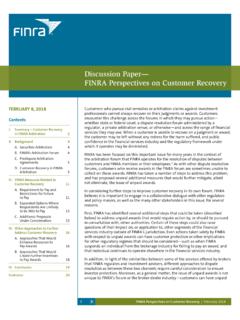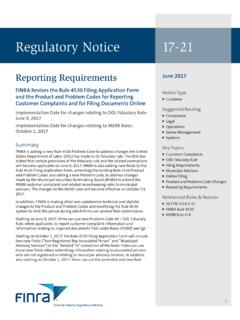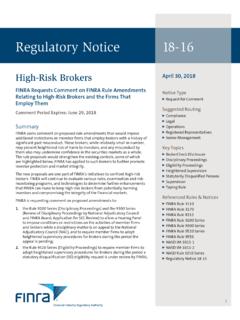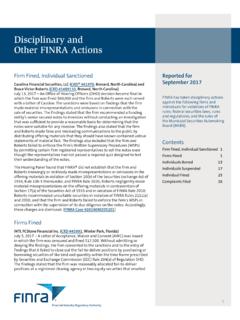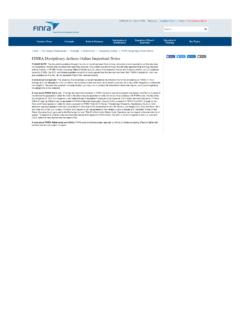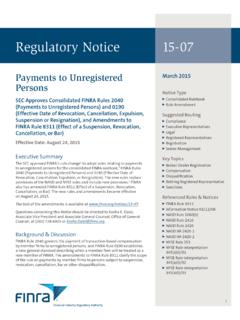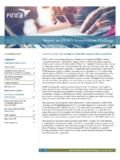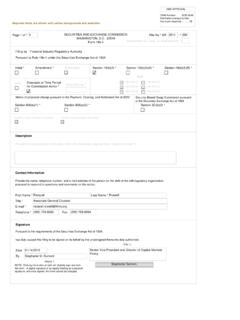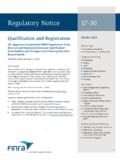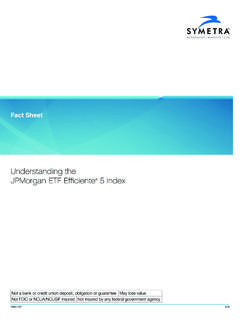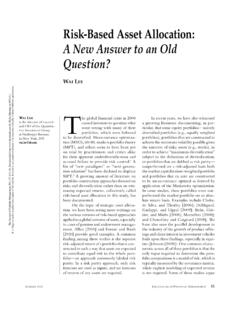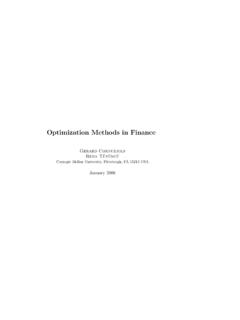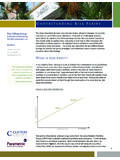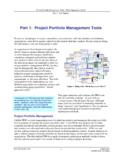Transcription of Report on Digital Investment Advice - finra.org
1 Report on Digital Investment Advice | March 20161 ContentsIntroduction 1A Note on Terminology 2A Brief History of Digital Investment Advice 2 Governance and Supervision 3 Investor Profiling 8 Rebalancing 11 Training 12 Lessons for Investors 13 Conclusion 14 Appendix 14 Endnotes 17 MARCH 2016 IntroductionTechnology has long played a central role in financial services innovation. It continues to do so today as many firms in the securities industry introduce new Digital Investment Advice tools to assist in developing and managing Investment undertook a review of selected Digital Investment Advice tools to assess these observations and practices in this Report are drawn from finra s discussions with a range of financial services firms that provide or use Digital Investment Advice tools, vendors and foreign securities regulators as well our regulatory experience.
2 This Report uses the term financial services firms to include both broker-dealers and Investment advisers. The rules discussed in this Report apply to broker-dealers. The effective practices we discuss are specifically intended for finra -registered firms, but may be valuable to financial professionals adoption of Digital Investment Advice tools has stimulated discussions about the role of financial professionals and the evolving relationship between financial intermediaries and their clients. What role will financial professionals play in conjunction with Digital services in providing Investment Advice ? To what degree will investors rely primarily on Digital Investment Advice ? How well can software know a client? Can the skill, knowledge and service provided by well-trained and ethical financial professionals be incorporated in software?
3 Can that software provide sound personal Advice , especially for clients with more complex Advice needs? Without venturing to answer these questions, what is clear is that the role technology plays in supporting Investment Advice to clients will increase at many securities With that in mind, finra issues this Report to remind broker-dealers of their obligations under finra rules as well as to share effective practices related to Digital Investment Advice , including with respect to technology management, portfolio development and conflicts of interest mitigation. The Report also raises considerations for investors in evaluating Investment Advice derived entirely or in part from Digital Investment Advice tools. This Report does not create any new legal requirements or change any existing broker-dealer regulatory obligations.
4 Throughout the Report , we identify practices that we believe firms should consider and tailor to their business Report FROM THE FINANCIAL INDUSTRY REGULATORY AUTHORITYR eport on Digital Investment Advice Report on Digital Investment Advice | March 20162 Questions/Further InformationInquiries regarding this Report may be directed to Daniel M. Sibears, Executive Vice President, Regulatory Operations/Shared Services, at (202) 728 6911; or Steven Polansky, Senior Director, Regulatory Operations/Shared Services, at (202) 728 Note on TerminologyAs used here, Digital Investment Advice tools (also referred to as Digital Advice tools) support one or more of the following core activities in managing an investor s portfolio: customer profiling, asset allocation , portfolio selection, trade execution, portfolio rebalancing, tax-loss harvesting3 and portfolio analysis.
5 These Investment Advice tools can be broken down into two groups: tools that financial professionals use, referred to here as financial professional-facing tools, and tools that clients use, referred to here as client-facing tools. Client-facing tools that incorporate the first six activities customer profiling through tax-loss harvesting are frequently referred to as robo advisors or robos. 4A Brief History of Digital Investment AdviceFinancial professionals have used Digital Investment Advice tools for years. These tools help financial professionals at each point in the value chain described above, for example, to develop an investor profile, to prepare proposals and sales materials, to develop an asset allocation or to recommend specific securities to an investor.
6 Those recommendations may be for individual securities, a customized portfolio or a pre-packaged portfolio for investors with a given profile. In addition, Digital tools can help develop recommendations to rebalance investors portfolios on a periodic basis or to support tax-loss harvesting. The tools financial professionals use may be developed by their firms, acquired from third-party vendors by their firm or, in some cases, acquired by the financial professionals the late 1990s, the landscape of Investment tools available directly to investors began to expand. Some firms started to make asset allocation tools available online. The landscape expanded further in 2005, when NASD Interpretative Material (IM) 2210-6 became effective, allowing broker-dealers to make Investment analysis tools available to investors.
7 finra defined an Investment analysis tool to be an interactive technological tool that produces simulations and statistical analyses that present the likelihood of various Investment outcomes if certain investments are made or certain Investment strategies or styles are undertaken. 5 Figure 1: Investment Advice value chain CustomerProfiling* asset allocation *Portfolio Selection*Trade Execution*Portfolio Rebalancing*Tax-Loss Harvesting*Portfolio Analysis**Governance and SupervisionCommunication and Marketing* Functionally typical in financial professional- and client-facing Digital Investment Advice tools** Functionally typical in financial professional-facing tools onlyReport on Digital Investment Advice | March 20163 Following the 2008 financial crisis, a number of new entrants began offering a wide range of Digital financial tools directly to consumers, including Investment Advice tools.
8 Many of these firms had their roots in the technology industry and brought new perspectives on the role of technology in financial services. The client-facing Digital Investment tools these firms developed offer aspects of the functionality previously only available to financial professionals. The degree of human involvement in client-facing tools varies substantially. Some firms rely on a purely Digital interaction with clients while others provide optional or mandatory access to a financial professional. In many cases, securities industry participants are responding with Digital Investment Advice strategies of their own. Some participants are developing or acquiring client-facing Investment Advice tools while others are developing or acquiring financial professional-facing tools to enhance their ability to serve clients and compete more effectively.
9 Some of these latter tools include advanced analytic tools , to assess customer risk tolerance or portfolio risk and in some cases presentation interfaces that enable the financial professional to present information to clients online. Vendors frequently position these tools as providing the basis for financial professionals to conduct more in-depth, sophisticated discussions with their and SupervisionGovernance and supervision of Investment recommendations are recurring topics of finra guidance and are equally relevant to Digital Investment Advice tools. We focus here on governance and supervision in two areas: 1) the algorithms that drive Digital Investment tools; and 2) the construction of client portfolios, including potential conflicts of interest that may arise in those are core components of Digital Investment Advice tools.
10 They use various financial models and assumptions to translate data inputs into suggested actions at each step of the Advice value chain. The methodology by which the algorithm translates inputs into outputs should reflect a firm s approach to a particular task, , profiling an investor, rebalancing an account or performing tax-loss harvesting. If an algorithm is poorly designed for its task or not correctly coded, it may produce results that deviate systematically from the intended output and that adversely affect many this reason, it is essential that firms effectively govern and supervise the algorithms they use in Digital - Advice tools. At the most basic level, firms should assess whether an algorithm is consistent with the firm s Investment and analytic approaches. For example, a number of client-facing Digital Investment Advice tools are based on precepts from Modern Portfolio Theory6 and use a passive, index-based approach to investing based on the risk tolerance of the client, while others incorporate active management of Investment portfolios.
